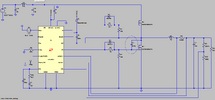Hi, does anyone know if there is a way to find NFETs for Synchronous Bucks?...How to search them?....As you know, a NFET for a Sync Buck must have Cgd at least 100 times less than Cgs. There is no way to search based on Cgd or Cgd/Cgs.
We need them for 17-32VIN, 13V5 OUT, 30A out, and for 17-58Vin, 13v5 out and 50A out.
We also need 4V5 gate drive.
Also, do you know if 4v5 NFETs are more likely to have CGS/CGD >100.
Also, synch FETs for synch Bucks need searching for based on trr and vf of their intrinsic diode...do you know how to search these out when no search engine refers to these parameters?
Also, for SMD FETs below 100V, which is the footprint that fits most of the other FETs aswell.?....there are so many , eg PowerDI5X6, PowerPak, Power-SO8 etc etc etc....its a myriad of confusion...which footprint (s) fit many of the other footprints too?
We need them for 17-32VIN, 13V5 OUT, 30A out, and for 17-58Vin, 13v5 out and 50A out.
We also need 4V5 gate drive.
Also, do you know if 4v5 NFETs are more likely to have CGS/CGD >100.
Also, synch FETs for synch Bucks need searching for based on trr and vf of their intrinsic diode...do you know how to search these out when no search engine refers to these parameters?
Also, for SMD FETs below 100V, which is the footprint that fits most of the other FETs aswell.?....there are so many , eg PowerDI5X6, PowerPak, Power-SO8 etc etc etc....its a myriad of confusion...which footprint (s) fit many of the other footprints too?
Last edited:

